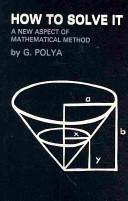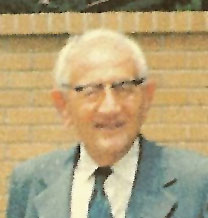[Jon Fripp, Michael Fripp, Deborah Fripp, Speaking of Science: Notable Quotes on Science, Engineering, and the Environment, https://books.google.com/books?id=44ihCUS1XQMC&pg=PA45, 2000, Newnes, 978-1-878707-51-2, 45]
Works

How to Solve It
George PólyaFamous George Pólya Quotes
Mathematical Methods in Science (1977)
Source: How to Solve It (1945), p. 207
Source: How to Solve It (1945), p. 70
Source: How to Solve It (1945), p. 219
2nd ed. (1957), p. xv
How to Solve It (1945)
George Pólya Quotes about mathematics
Induction and Analogy in Mathematics (1954)
Induction and Analogy in Mathematics (1954)
Induction and Analogy in Mathematics (1954)
Mathematical Methods in Science (1977)
Mathematical Methods in Science (1977)
Context: We wish to see... the typical attitude of the scientist who uses mathematics to understand the world around us.... In the solution of a problem... there are typically three phases. The first phase is entirely or almost entirely a matter of physics; the third, a matter of mathematics; and the intermediate phase, a transition from physics to mathematics. The first phase is the formulation of the physical hypothesis or conjecture; the second, its translation into equations; the third, the solution of the equations. Each phase calls for a different kind of work and demands a different attitude.<!--p.164
“I… present also examples of historic interest, examples of real mathematical beauty”
Induction and Analogy in Mathematics (1954)
Context: I... present also examples of historic interest, examples of real mathematical beauty, and examples illustrating the parallelism of the procedures in other sciences, or in everyday life.
George Pólya Quotes about problems
George Pólya, Mathematical Discovery: On Understanding, Learning, and Teaching Problem Solving (1962)
“If you cannot solve the proposed problem, try to solve first a simpler related problem.”
Mathematical Methods in Science (1977), p.164
Mathematical Methods in Science (1977)
George Pólya Quotes
“Anything new that we learn about the world involves plausible reasoning”
Induction and Analogy in Mathematics (1954)
Context: Demonstrative reasoning penetrates the sciences just as far as mathematics does, but it is in itself (as mathematics is in itself) incapable of yielding essentially new knowledge about the world around us. Anything new that we learn about the world involves plausible reasoning, which is the only kind of reasoning for which we care in everyday affairs.
Mathematical Methods in Science (1977), p.161
Induction and Analogy in Mathematics (1954)
Context: The efficient use of plausible reasoning is a practical skill and it is learned... by imitation and practice.... what I can offer are only examples for imitation and opportunity for practice.
Mathematical Methods in Science (1977)
Context: Life is full of surprises: our approximate condition for the fall of a body through a resisting medium is precisely analogous to the exact condition for the flow of an electric current through a resisting wire [of an induction coil]....
m\frac {dv}{dt} = mg - Kv
This is the form most convenient for making an analogy with the "fall", i. e., flow, of an electric current.
... in order from left to right, mass m, rate of change of velocity \frac {dv}{dt}, gravitational force mg, and velocity v. What are the electrical counterparts?... To press the switch, to allow current to start flowing is the analogue of opening the fingers, to allow the body to start falling. The fall of the body is caused by the force mg due to gravity; the flow of the current is caused by the electromotive force or tension E due to the battery. The falling body has to overcome the frictional resistance of the air; the flowing current has to overcome the electrical resistance of the wire. Air resistance is proportional to the body's velocity v; electrical resistance is proportional to the current i. And consequently rate of change of velocity \frac {dv}{dt} corresponds to rate of change of current \frac {di}{dt}.... The electromagnetic induction L opposes the change of current... And doesn't the inertia or mass m..? Isn't L, so to speak, an electromagnetic inertia?
L\frac {di}{dt} = E - Ki
Mathematical Methods in Science (1977)
Context: The volume of the cone was discovered by Democritus... He did not prove it, he guessed it... not a blind guess, rather it was reasoned conjecture. As Archimedes has remarked, great credit is due to Democritus for his conjecture since this made proof much easier. Eudoxes... a pupil of Plato, subsequently gave a rigorous proof. Surely the labor or writing limited his manuscript to a few copies; none has survived. In those days editions did not run to thousands or hundreds of thousands of copies as modern books—especially, bad books—do. However, the substance of what he wrote is nevertheless available to us.... Euclid's great achievement was the systematization of the works of his predecessors. The Elements preserve several of Eudoxes' proofs.
“Simplicity is worth buying if we do not have to pay too great a loss of precision for it.”
Mathematical Methods in Science (1977), p.215
Mathematical Methods in Science (1977)
Context: Even if without the Scott's proverbial thrift, the difficulty of solving differential equations is an incentive to using them parsimoniously. Happily here is a commodity of which a little may be made to go a long way.... the equation of small oscillations of a pendulum also holds for other vibrational phenomena. In investigating swinging pendulums we were, albeit unwittingly, also investigating vibrating tuning forks.<!--p.224
“As for the human race, so for the human child.”
Introduction
Mathematical Methods in Science (1977)
Context: In my presentation I... follow the genetic method. The essential idea... is that the order in which knowledge has been acquired by the human race will be a good teacher for its acquisition by the individual. The sciences came in a certain order; an order determined by human interest and inherent difficulty. Mathematics and astronomy were the first sciences really worth the name; later came mechanics, optics, and so on. At each stage of its development the human race has had a certain climate of opinion, a way of looking, conceptually, at the world. The next glimmer of fresh understanding had to grow out of what was already understood. The next move forward, halting shuffle, faltering step, or stride with some confidence, was developed upon how well the [human] race could then walk. As for the human race, so for the human child. But this is not to say that to teach science we must repeat the thousand and one errors of the past, each ill-directed shuffle. It is to say that the sequence in which the major strides forward were made is a good sequence in which to teach them. The genetic method is a guide to, not a substitute for, judgement.
Induction and Analogy in Mathematics (1954)
Source: How to Solve It (1945), p. 148
Source: How to Solve It (1945), p. 113
Induction and Analogy in Mathematics (1954)
Mathematical Methods in Science (1977)
“The best of ideas is hurt by uncritical acceptance and thrives on critical examination.”
Source: How to Solve It (1945), p. 100
Donald E. Knuth, comments at Pólya's 90th birthday celebration quoted by Gerald L. Alexanderson, The Random Walks of George Polya (2000)
Source: Mathematical Discovery (Volume 1), p. 6
